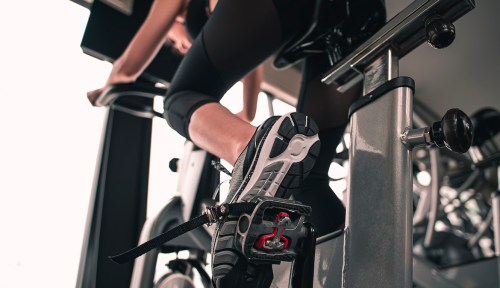I’m sipping an impeccably dry rosé with a friend, catching up and lamenting about how the pandemic has shot my workout routine to hell. It’s been virtually impossible to find that gusto to “get back on the wagon” again. I’ve gone from exercise being a cemented fixture in my daily routine (Pilates, spin, walking, running, personal training) to not even having the energy to get off the couch to walk my dog.
Experts in This Article
Connor Darnbrough is the co-founder of The Smart Fit Method.
co-founder of the Smart Fit Method, a fitness program designed to optimize cardiovascular health through exercise robotics and AI
As I’m sure many of you can understand—particularly given that this has been a bit of an epidemic within a pandemic—this has had its own detrimental mental health effects, too.
After listening to my vent sesh, said friend stops me and says she has a potential solution. “I have something your Virgo brain is going to love,” she says. “AI workouts.”
Turns out, she’s discovered a brand new take on exercise, in an unsuspecting studio in San Diego: The Smart Fit Method. The plan involves three 20-minute workout sessions per week, customized to your personal capabilities based on artificial intelligence. And with just an hour total each week, she (along with some friends) were making massive changes to their body composition, strength, and endurance.
Sandwiched between surfer dive bars and a Patagonia store, overlooking the Pacific, this boutique personal training studio is filled with machines that look like a cross between medieval torture devices and the Chuck Norris total gym. And, of course, a machine from NASA sprinkled in. Science!
The method
When you sign up for Smart Fit, you have access to all the machines, but the method in Smart Fit Method is that you have three sessions a week; one on each machine. And for each of those sessions, you’ll be in and out in 20 minutes (unless you hang around for recovery, that is). You can do drop-ins, or sign up for six-week challenges or an annual membership starting at $299 per month.
The machines
The ARX Smart 3 and Smart 5
Arguably the scariest of the bunch, and the one that most definitely looks like a torture device, this set of strength machines comprises leg presses, chest presses, rows, overhead presses, pulldowns, and more. It uses a computer controlled motor to adapt to the exact amount of resistance you need in each and every rep. The machines also save your pre-set range of motion, height, and limb length (like an advanced version of the driver’s seat presets in your car). And the screen allows you to monitor in real time how much you’re lifting, lowering, pushing, pulling, and resisting in your concentric and eccentric movements.
Vasper
My favorite. This NASA-developed machine hooks you up to tubes and cuffs, and makes you feel like an elite athlete. Vasper uses super cold water in cuffs around your legs, arms, and neck to drop your body temp. It also creates blood flow restriction by tightening those appendage cuffs to optimize your workout, add to the “burn,” and so much more. Apparently this is also a fave of Dave Asprey’s (the Bulletproof founder), and it’s hard to find outside of super elite, ultra expensive boutique fitness studios.
CAROL
For smarter cardio, The Smart Fit Method uses the CAROL stationary bike. If a Peloton used artificial intelligence and had a nice British lady’s voice telling you that a saber tooth tiger is chasing you and you have to pedal to survive, it would be a CAROL. The AI assesses your abilities overall and within each session based on your output, then personalizes your resistance so you’re getting a workout that’s customized to exactly where you are, physiologically.
The score
The team at Smart Fit is currently developing a proprietary score that “provides overall metrics to each member to measure how fitness is impacting their longevity,” says CEO Rob Darnbrough.
This will be an amalgam of points across an individual’s health profile: The score focuses on strength gains (push, pull, and drives), cardiovascular improvements (based on the octane score from the CAROL bike), cellular health improvements (like heart rate variability), and body composition changes (body fat percentage, lean mass improvements, circumference measurements), and more.
“Instead of measuring just one factor like just body composition, we measure multiple data points to come up with a holistic score,” says co-founder Connor Darnbrough. “This approach will benefit each member in focusing their efforts on fitness to improve longevity,” adds Rob Darnbrough.
Members are able to access their score and log their progress through the app, making it easy to get a read on exactly where they are, and what they need.
My experience
My first few minutes at the seaside fitness oasis began with an espresso—yes, coffee!—which was always complimentary pre-workout (and very European). This made sense to me; caffeine is a solid performance enhancer, and has been studied for its effects on exercise.
Then I went into the introductory body scan; every member gets their onboarding scan and then regular check-ins as often as once a week. This body-composition analyzer was like a DEXA scan (like the one they use at Modern Age), without the radiation. The 360-degree cameras were able to take a comprehensive, 3D image of my body (in a silvery grey, The Secret World of Alex Mack kind of human blob). The trainers went over my results so I’d understand my baseline health, and identified areas in which I could improve (like changing my composition to a little less fat, a little more muscle; working on posture; and improving my resting heart rate).
From there, I did an intro workout on my first machine: the Smart 5. As you may have gathered, that workout was hard AF, so I definitely needed some recovery afterward. Fortunately I was able to use the PEMF table, which uses electromagnetic pulses to reduce inflammation, improve circulation, and aid recovery. Smart Fit also has a cooling table, which is like a giant cold pack for your entire body.
I continued my three workouts per week for six weeks, which accounted for six hours total of exercise. It was all I did aside from my typical weekly Pilates session and walking. And y’all, the experience was jarring. In just 20 minutes, you feel as exhausted and shaky as if you’ve just run a half marathon or did an hourlong, insane Crossfit workout. My brain couldn’t connect the dots. But even though it was absurdly challenging, it felt empowering.
And while my physique results were personally impressive to me (I lost three percent of my fat mass, and a half inch on my waist), what really blew my mind were the improvements in my strength, which was automatically quantified thanks to the AI and robotics.
I saw improvement across every measured area. Most exciting was how much more I could resist and push in the eccentric and concentric movements of the chest presses, leg presses, and rows. On day one, I could resist 525 pounds in a leg press; by the end, I could resist 655 pounds—a 25 percent improvement, and 120 more pounds! I saw a 14 percent improvement in my rows (adding 17 pounds), and a roughly 8 percent improvement in my chest presses (adding 10 pounds).
I’ve been reporting on fitness for nearly a decade now, and covered a lot of new methods and exercise styles that promise to change the way you work out, but end up being another flash in the pan. I can say with certainty that what is going on at The Smart Fit Method isn’t a gimmick. They’re developing an approach that will shift how we view exercise and measure health.
If you’re in the San Diego area or near their studio on Kauai, Hawaii, stopping in here is an absolute must (the first session is free, btw!). And if you’re not, keep an eye out for their rapid expansion over the next year.
Oh hi! You look like someone who loves free workouts, discounts for cutting-edge wellness brands, and exclusive Well+Good content. Sign up for Well+, our online community of wellness insiders, and unlock your rewards instantly.
Sign Up for Our Daily Newsletter
Get all the latest in wellness, trends, food, fitness, beauty, and more delivered right to your inbox.
Got it, you've been added to our email list.










